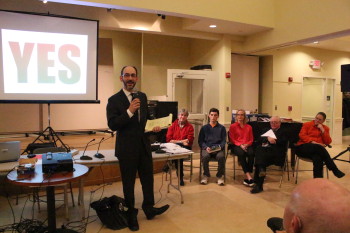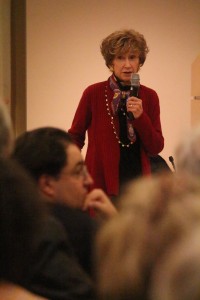Photo: Residents attending the final Precinct Meeting before the Town Election on April 7.
The community room at the Beech Street Center was filled Monday, March 30 with more than 200 residents who came to attend the final Precinct Meeting hosted by the Belmont Board of Selectmen and the Financial Task Force.
But it wasn’t so much the opportunity to hear, once again, the details of the town’s fiscal 2016 budget and the Proposition 2 1/2 override on the April 7 Town Election ballot; there have been more than a dozen presentations to the public and groups in March.
Rather, it was a last-minute addition to the agenda that brought the crowd to the center: the opportunity to hear presentations and have public questions answered from representatives of the two sides of the override question facing voters.
And while the position of those seeking the passage of the $4.5 million, multiyear override has been articulated to the public for several weeks – approving the override is necessary to prevent large cuts to school personnel and programs – Monday would be the first time those calling for a “no” vote would detail its opposition and the course of action if it is successful in defeating the ballot question.
For Adam Dash, who has become the voice of the “Yes for Belmont” committee in the past week, the argument for backing the override – which will add approximately $650 in taxes annually to the “average” Belmont house valued at $847,000 – is simple enough: the time has come to pay the rent.

With 49 line-item cuts in the school department’s fiscal ’16 budget, “it’s mind–numbing it’s so long,” he said.
“It’s … a time to stand up and do what we need to do to accomplish the goals of the town,” said Dash, standing behind a slide with an orange “Yes” behind him.
He also questioned the “No” side’s assurances that the a $4.5 million override is not needed as additional revenues can be found to fund the schools this year “are just assumptions, and assumptions can be wrong.”
Dash compared those pushing the ballot question with complaints of teacher salaries and contract negotiations to Shakespeare’s King Lear bellowing into the tempest, (“Spit, fire; spout, rain”) as they rage against what is out of their reach.
“When the house is on fire, we have to … act now and then do other things later,” Dash said.
“In the big picture, it’s what do you value?” said Dash, saying good education and educators costs money.
“Yes is the action moving forward … and looking at long-range planning while no is just the same old system where we just kicked the can down the road,” he said, telling the audience the easiest way to remember that the override ballot is on the back of the ballot is to recall the phrase, “back the override.”
Holding court for the Vote No on Ballot Question 1 Committee was current Planning Board member and former Warrant Committee Chair Elizabeth Allison, who started by praising “this wonderful town” with many great qualities including a “terrific” school system that, if it was its “small country,” Belmont students would quantitatively be “the best in the world.”

The No committee’s starting point is the same as those supporting the override; funding a level service budget for the schools in fiscal ’16, knowing it will need $1.7 million in additional revenue to bridge the deficit gap.
“The school bus is in the ditch, and we need to pull it out,” said Allison.
But what the no committee doesn’t accept is the path override supporter are mapping. While saying she has admiration for the work of the Financial Task Force, but its financial projections for the town’s revenue growth is “too pessimistic,” running below the ten-year average.
While the no committee bulwarked its argument with data and numbers, its also sought to make political points with voters by attacking labor and unions. While much as been made of the skyrocketing enrollment forecast of nearly 800 more students in the next ten years and accelerating costs in special education and English language instruction, Allison pointed to teachers pay and other compensation as being the greatest cost driver impacting the school budget.
A victory on election day for the ‘Yes’ position “will ratify the hard-liners in the teacher’s union who say, ‘Just keep on going … push through five percent, five-and-a-half percent pay increases a year,” said Allison.
With higher taxes on households, another expensive collective bargaining settlement and higher overall municipal expenses, Allison said voters would not be in the position to support the much needed new Belmont High School with a temporary debt exclusion that will top $1,000 over several years.
Allison outlined the No committee’s alternative course of action, “a road better taken,” to that of the override; calling on the Board of Selectmen to form a “work group” – to include the “new school committee member with an MBA from a school out west” – to produce a “new spin-on-the-ball revenue forecast” since it does not believe the current low estimate.
In addition, the new group would look at cost solutions and seek reallocation of funds “from one department to another” to fill the gap the schools face.
If at the end of that process there remains a deficit, the Board of Selectmen can then call a special election to vote on a “reasonable and justified override on the ballot.”
The No approach provides transparency, keeps taxes down and prepare for the fiscal 2017. Allison suggested one way to cut future costs was for the Superintendent of Schools John Phelan to seek a waiver of the state unfunded mandate on teaching children requiring English learning.
(After the meeting, Phelan said no district has been granted such a waiver and those systems that have not followed the state requirements “to the letter” have been taken to court.)
Selectman Mark Paolillo, a member of the Financial Task Force, defended the revenue projections noting he felt “comfortable enough” with the task force’s assumptions.
During the one-hour long question and answer segment of the meeting, the majority of questions were directed to the No committee, seeking clarification to its blueprint.
Allison said many concerns from Yes supporters will be resolved when the added revenue “baked in” the budget estimates is uncovered. And even if the no side’s estimates “fell short,” most residents will vote for a new, modest override, “perhaps not happily but its so much better for the schools than the alternatives.”
“In the end, people will not damage the schools,” Allison said.
“This approach is a one-year Band-Aid; you’re going to right back where you were. It doesn’t solve anything,” said Dash. “We can build a beautiful high school but if you have a deficient program, what’s the point?”
When asked if the No committee could guarantee that the schools will be adequately funded next year if the overrides doesn’t pass, Allison said there is “a high probability” that nearly the entire $1.7 million needed with more realistic revenue projections.
In addition, Allison said if the $4.5 million override passes, the town is not required to use the entire amount where proponents hoped it would go.
“You have no guarantee that the large designated slice of the pie will go to the schools,” suggested Allison, adding that if there in no cost containment on teacher salaries, it will be very difficult to sustain the schools.”
Asked by a Belmont High School freshman the effects of losing “20 teachers” if the override fails, Robert Sarno, one of the leaders of the “No” committee as well as the chairman of the Warrant Committee’s subgroup that analyzes the school budget, said even in the worse case scenario, only about six or seven full-time equivalent teaching positions will be lost.
“You’re not going to lose that many teachers,” said Sarno.
In the most illustrative moment, Phelan demonstrated Belmont’s student to teacher ratio in relation to all districts in Massachusetts. Holding up six pages from a state-issued report, Phelan took out the fifth page to show that Belmont’s 17.1 ratio is far from the state average of 13.6.
“We’re not that far from the sixth page, and that has only four entries,” he said.
The final question came from a resident concerned that High School students are not meeting the hours of instruction the state requires each pupil to obtain.
Phelan said many upperclassmen at the high school are barely meeting that minimum and “I believe our hours will be at risk” if the override fails.
“I encourage that if [the override] doesn’t win, that those people who supported it, call the state,” referring to an intervention by the Massachusetts Department of Elementary and Secondary Education.